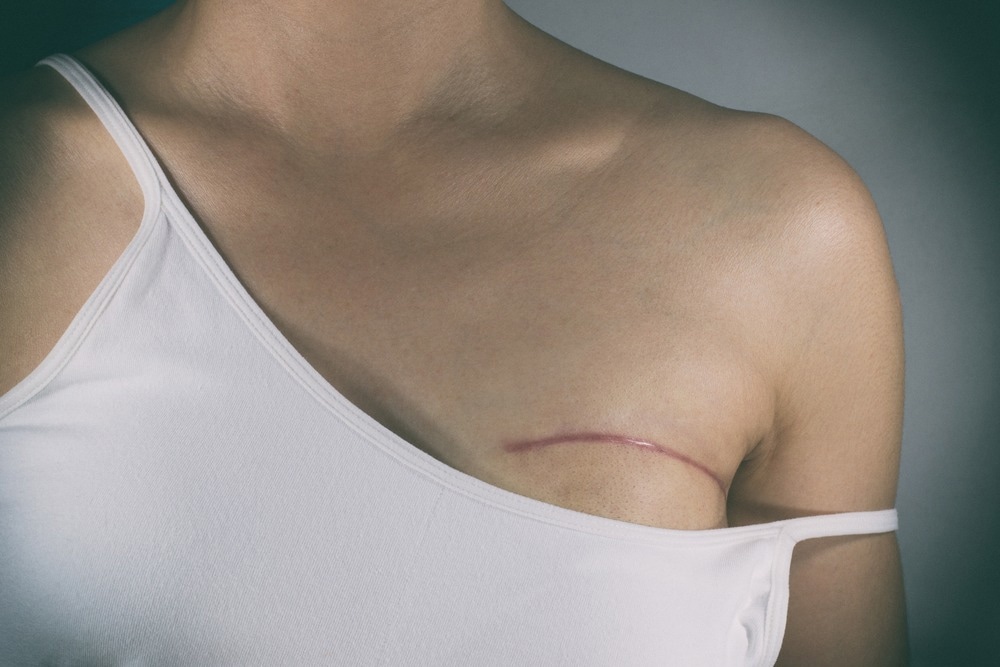In a recent study published in JAMA Surgery, a group of researchers evaluated the safety and feasibility of a single-port (SP) robotic-assisted approach for performing nipple-sparing mastectomies (NSM).
 Study: Safety and Feasibility of Single-Port Robotic-Assisted Nipple-Sparing Mastectomy. Image Credit: Pradit.Ph/Shutterstock.com
Study: Safety and Feasibility of Single-Port Robotic-Assisted Nipple-Sparing Mastectomy. Image Credit: Pradit.Ph/Shutterstock.com
Background
Since its introduction in 1985, robotic-assisted surgery has evolved beyond gastrointestinal, urologic, and gynecologic surgeries to include areas like thyroidectomy and reconstructive surgeries. Offering the same safety and efficacy as open surgery but with faster recovery and improved cosmetic results, it has advanced to robotic nipple-sparing mastectomy (rNSM).
First described in 2015, rNSM has shown comparable safety and oncologic outcomes to traditional methods. Challenges with the multiport system led to the SP da Vinci system, enhancing maneuverability and reducing complications. Despite its proven safety and potential for better sensation preservation, the SP system's adoption is limited by the surgical learning curve, reconstruction variability, and insufficient patient-reported outcomes.
Further research is needed to address the limitations of the SP robotic system, particularly in understanding its long-term oncologic outcomes, optimizing the surgical learning curve, and evaluating patient-reported outcomes for breast reconstruction.
About the study
The study conducted at a large university hospital involved 20 patients undergoing bilateral SPrNSM with tissue expander reconstruction from February 1, 2020, to January 4, 2023. Candidates for this procedure included women who were eligible for NSM according to standard care, with specific exclusion criteria such as tumor involvement of the skin, large breast size, and heavy smoking.
The surgical procedure began with an axillary incision to facilitate sentinel lymph node dissection using the da Vinci SP Robotic Surgical System. The breast tissue was dissected from the pectoralis muscle, and the procedure was performed in a 12° reverse Trendelenburg position for better visualization and ease of gland removal. The single-port system, equipped with a flexible 3D camera and robotic arms, allowed for a more streamlined operation with fewer complications from arm collisions.
Post-surgical reconstruction was handled by a plastic and reconstructive surgeon using a prepectoral expander covered in acellular dermal matrix. These were secured to the chest wall, and the amount of expander filling was based on the skin envelope laxity and pocket size. The final reconstruction step involved either breast implant placement or autologous reconstruction surgery, based on the patient's choice and the surgeon's discretion.
The study assessed post-surgical nipple and skin sensation using the Semmes-Weinstein Monofilament test and recorded clinical outcomes, including Body Mass Index (BMI), breast size, age, tumor characteristics, lymph node status, and early complications classified by the Clavien-Dindo system.
Study results
Between February 1, 2020, and January 4, 2023, a cohort of 20 female patients aged 29 to 63 years underwent bilateral SPrNSM with immediate reconstruction using prepectoral implants. The group's demographic and clinicopathological features varied, including 5 Hispanic/Latina, 13 White, 1 African American/Black, and 1 other who preferred not to disclose their race. No insurance issues were encountered. In the study, twenty patients with preoperative breast sizes ranging from A to D cup underwent bilateral SPrNSM for either risk reduction (11 patients, mostly with genetic predispositions) or existing breast cancer (9 patients).
Preoperative procedures included sentinel lymph node biopsies and axillary lymph node dissections, with three patients receiving neoadjuvant chemotherapy for invasive ductal carcinoma. The final pathology showed benign conditions in 11 patients and carcinoma in others, with most being estrogen/progesterone receptor positive and Erb-B2 Receptor Tyrosine Kinase 2 (ERBB2) negative. Surgical times varied from 205 to 351 minutes without any conversions to open procedures, and median robotic console times improved, indicating increased surgical efficiency. Median incision size was 4 cm, and blood loss was minimal.
In terms of complications, there was one instance of bilateral skin necrosis attributed to excessive postoperative ice pack use, requiring surgical revision. Another patient developed a unilateral expander infection, leading to its removal and washout. Overall, the complication rate was low.
Postoperative Nipple Areolar Complex (NAC) and breast skin sensation were also assessed. In the latter half of the cohort, measurable NAC sensation was preserved in 65% of the breasts two weeks post-surgery, and 50% retained sensation at six months. Skin sensation was even more favorable, with 90% and 100% preservation at two weeks and six months, respectively. In the first half of the cohort, prior to routine sensation testing, 65% reported measurable NAC sensation.
Conclusion
This study underscores the effectiveness and safety of SPrNSM, indicating its potential as a viable option for patients seeking breast cancer treatment or risk reduction, with promising outcomes in terms of operative efficiency, complication rates, and preservation of breast and NAC sensation.
Journal reference:
- Farr DE, Haddock NT, Tellez J, et al. Safety and Feasibility of Single-Port Robotic-Assisted Nipple-Sparing Mastectomy. JAMA Surg., 2024. doi:10.1001/jamasurg.2023.6999
https://jamanetwork.com/journals/jamasurgery/article-abstract/2813933?utm_campaign=articlePDF&utm_medium=articlePDFlink&utm_source=articlePDF&utm_content=jamasurg.2023.6999